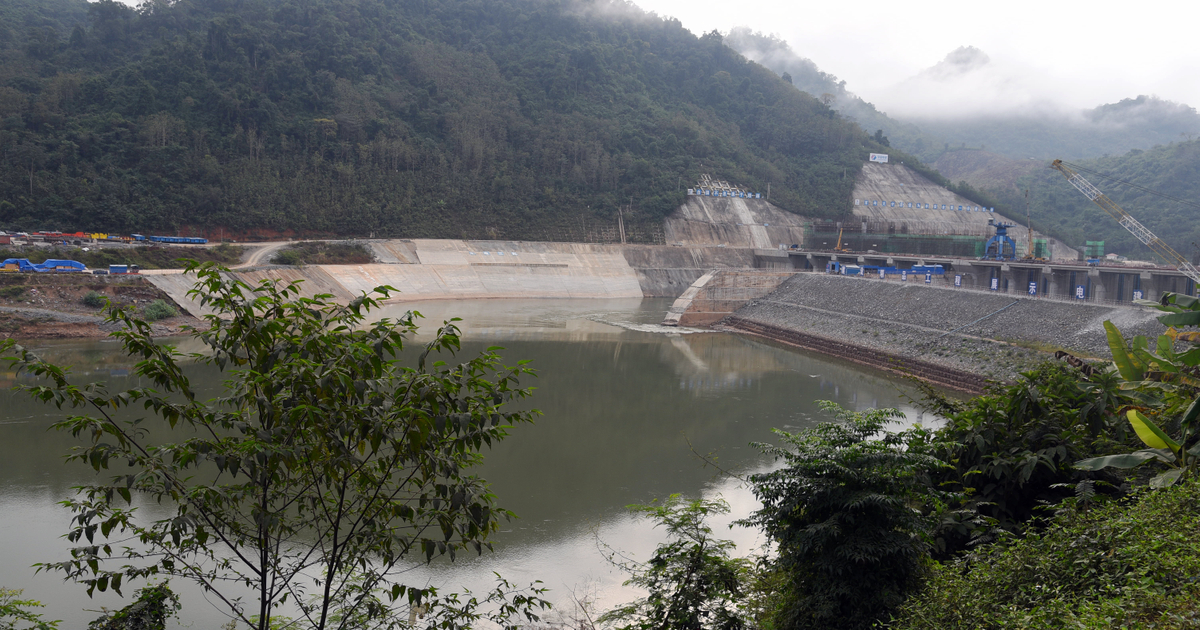Revolutionizing SEO With Google’s Search Generative Experience via @sejournal, @VincentTerrasi
Explore the synergy of human expertise and AI tools for superior content optimization and search relevance. The post Revolutionizing SEO With Google’s Search Generative Experience appeared first on Search Engine Journal.

The advent of Google’s Search Generative Experience (SGE) is revolutionizing online search, ushering in a new era of contextualization and intuition in information discovery.
This technological advancement is fundamentally changing SEO strategies, requiring professionals to adopt a new approach to content creation.
The impact on users is equally significant, with AI greatly facilitating access to search results.
This article proposes an advanced thematic mapping approach to maximize the effectiveness of these technologies in SEO.
It also discusses the knowledge of large language models (LLMs) such as OpenAI’s GPT, Google’s Bard, and Microsoft’s Bing AI, highlighting their limitations and potential in SEO content creation.
The Arrival Of Google SGE
Google SGE marks a revolutionary shift in online search. This innovation sees Google take a more contextual and intuitive approach to information retrieval.
This development has a significant impact on how SEO professionals need to think and plan their content strategies.
The user experience is also changing, as AI-guided search results are easier to find.
Answers are quickly accessible without having to sift through multiple tabs and pages.
Understanding how this AI works and extracting its knowledge using new methods is essential to position yourself effectively and understand its limitations.
Understanding Large Language Models (LLMs)
LLMs such as GPT, Bard, and Bing AI are powerful tools with impressive natural language generation and understanding capabilities.
However, these models have limitations, particularly when it comes to understanding specific contexts and updating information.
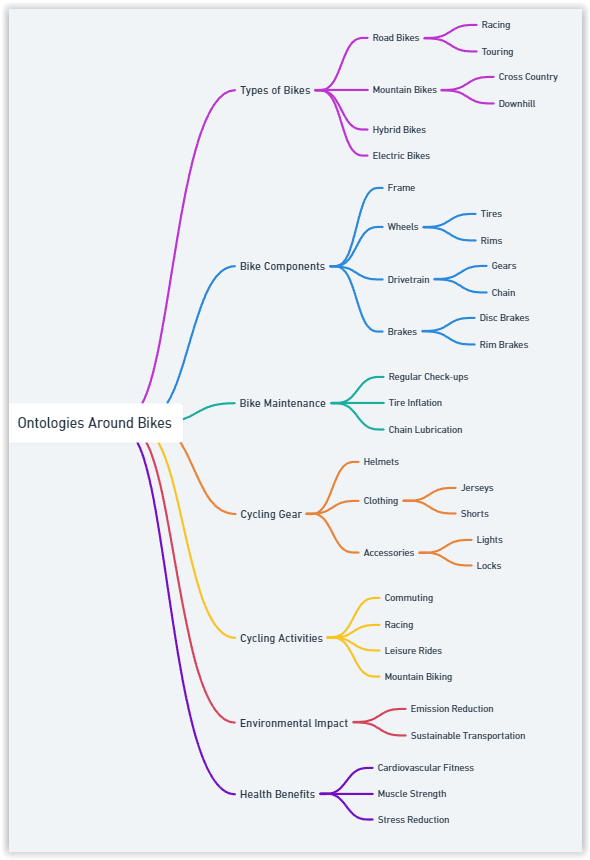 Image from author, January 2024
Image from author, January 2024
SEO project staff need to understand these limitations in order to maximize their content creation efficiency.
There are two types of knowledge: that which comes from the data used for training and that which is in the search engine index and is used as part of the answers.
To illustrate this, I’d like to show you how we can map this knowledge.
Thematic Mapping Importance
Thematic mapping is a critical tool in SEO that organizes and structures content in a logical and intuitive way.
It ensures that all facets of a topic are covered, increasing the relevance and quality of the content. Using an LLM for thematic mapping offers unique advantages in generating new ideas and perspectives.
Structuring A Thematic Map
Topic mapping is the practice of grouping related ideas and topics into clusters to facilitate the creation of coherent and comprehensive content.
This approach not only helps to organize ideas in a logical way but also to identify gaps in existing content.
Topic Map Architecture
Choice Of Topic And Keywords
Choose a niche topic and identify the relevant keywords. You can start with the LLM of your choice, but I prefer one approach.
The first is to use Google’s AI, such as PaLM 2 if you have a good command of Google’s tools (for your information, I have set up a training course on Data Marketing Labs).
Here’s a very simplified prompt to get the ontologies present in ChatGPT:
Give me a list in a table of the ontologies around “YOUR CONCEPT.”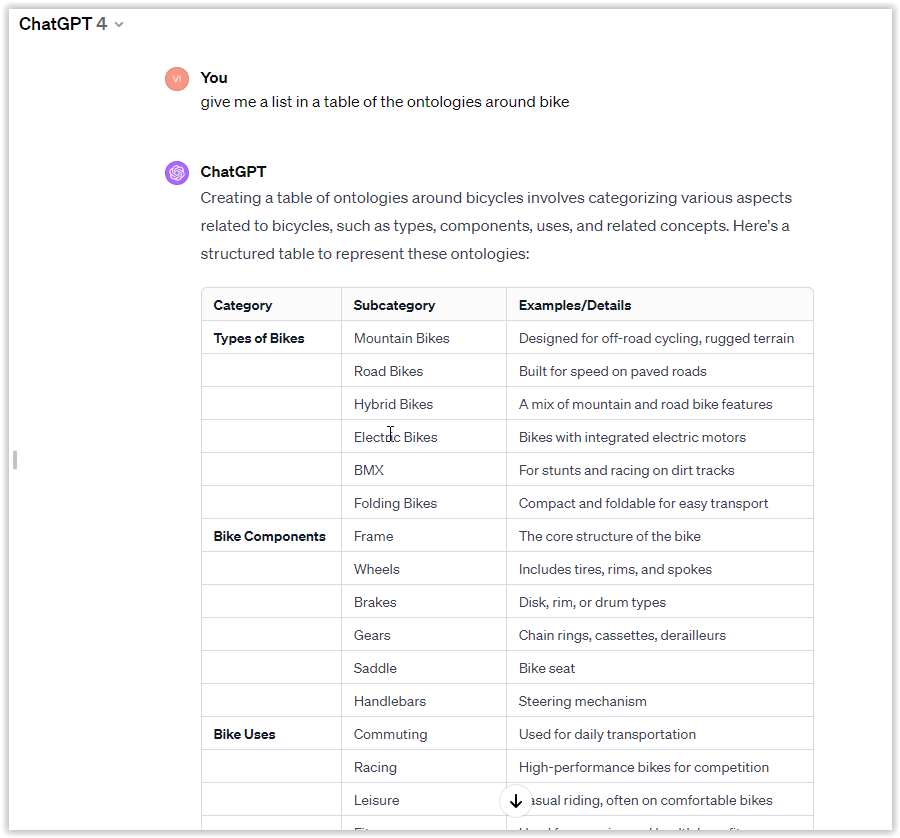 Screenshot from ChatGPT 4, January 2024
Screenshot from ChatGPT 4, January 2024
Brainstorming
For each expression, you’ll ask the LLM to brainstorm by creating several passages related to the expression.
I’m often asked why I make several passages. The answer is simply because, depending on the creativity threshold and the answers in Google’s index, the LLM may have slightly different answers, and this allows the field of possibilities to be included.
Here’s a picture where I’m using PaLM 2 to generate topics that the AI knows perfectly well and that are searched for by web users. The more topics you ask for, the better the coverage of your topic.
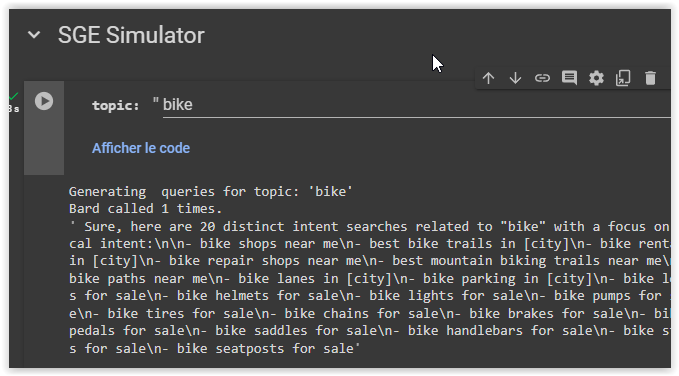 Screenshot from SGE Simulator, January 2024
Screenshot from SGE Simulator, January 2024
Extraction
Next, you can extract all the entities mentioned in relation to a concept.
In the beginning, I used Python libraries, but now you can use an LLM because the task is very simple for it.
In the end, everything is stored in an array, and you can count the number of times a concept appears. I’d like to explain this part in more detail.
In this image, you can see that for each of the previous topics, I’m doing five generations to try to recover as many relevant elements as possible, which will help me generate the mind map.
For each generated text, I use PaLM 2 to extract the important terms, and everything is stored in a table.
 Screenshot from PaLM 2, January 2024
Screenshot from PaLM 2, January 2024
As you can see, each step takes place in a Google Colab, which provides ready-to-use tables and makes it easy to sort your data with a few clicks.
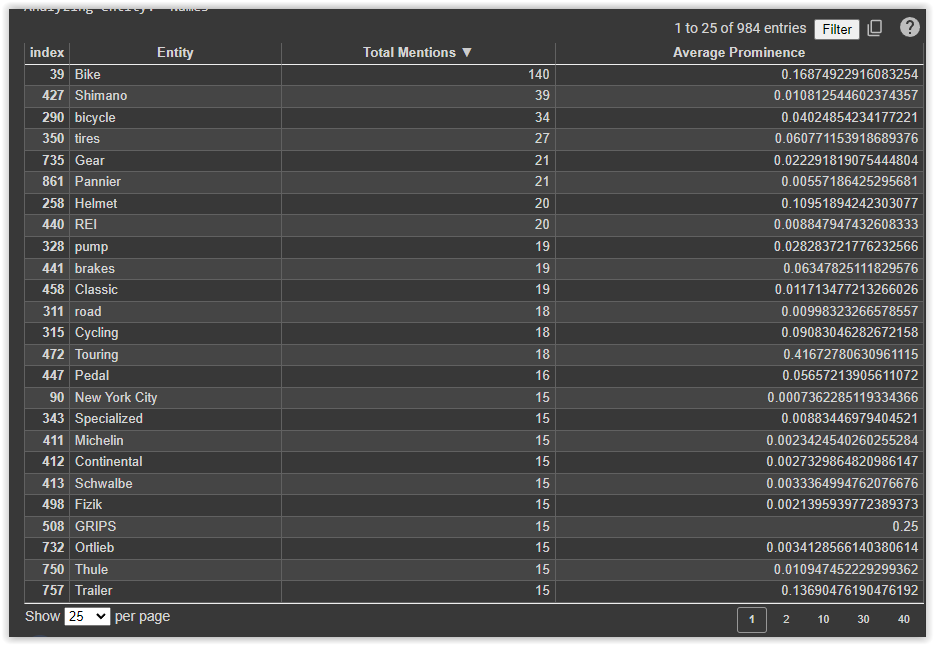 Screenshot from Google Colab, January 2024
Screenshot from Google Colab, January 2024
Next, you can build the thematic map from this prompt.
 Screenshot from author, January 2024
Screenshot from author, January 2024
Here’s a possible result:
**Step 1: Topical Map Creation**
**Topic:** Bike
**Nouns/Predicates:**
**1. Bike Types**
– Peloton bike
– Electric bike
– Mountain bike
– Road bike
**2. Bike Components**
– Sound bike boy bell
– Bike clips
– Bike pedals
– Road bike pedals
**3. Bike Activities**
– Run walk bike regularly
– Human fully aware bike
**4. Bike Accessories**
– Mountain bike tires
**5. Bike Safety**
**Step 2: Semantic Graph**
| Subtopic 1 | Subtopic 2 | Semantic Connection |
|—|—|—|
| Peloton bike | Electric bike | Both are types of bikes that are powered by electricity. |
| Electric bike | Sound bike boy bell | Both are components that can be added to a bike. |
| Sound bike boy bell | Human fully aware bike | Both are related to the safety of the rider. |
| Human fully aware bike | Run walk bike regularly | Both are related to the physical activity of riding a bike. |
| Run walk bike regularly | Mountain bike tires | Both are related to the terrain that a bike can be ridden on. |
| Mountain bike tires | Road bike pedals | Both are components that can be added to a bike. |
| Road bike pedals | Bike clips | Both are components that can be added to a bike. |
**Step 3: Mind Map**
**Topic:** Bike
**Subcategories:**
1. Bike Types
– Peloton bike
– Electric bike
– Mountain bike
– Road bike
– BMX bike
2. Bike Components
– Sound bike boy bell
– Bike clips
– Bike pedals
– Road bike pedals
– Bike seat
3. Bike Activities
– Run walk bike regularly
– Human fully aware bike
– Bike racing
– Bike touring
– Bike commuting
4. Bike Accessories
– Mountain bike tires
– Bike helmet
– Bike lights
– Bike pump
– Bike rack
5. Bike Safety
– Bike brakes
– Bike reflectors
– Bike locks
– Bike insurance
– Bike maintenance
6. Bike Brands
– Specialized
– Trek
– Giant
– Cannondale
– Scott
7. Bike Shops
– REI
– Performance Bike
– Dick’s Sporting Goods
– Walmart
– Target
8. Bike Events
– Tour de France
– Giro d’Italia
– Vuelta a España
– Tour of California
– USA Cycling National Championships
9. Bike Clubs
– The League of American Bicyclists
– Sierra Club
– National Bike Club
– Adventure Cycling Association
– Bikers Against Child Abuse
10. Bike Advocacy
– People for Bikes
– Rails-to-Trails Conservancy
– Bike Walk Alliance
– National Center for Safe Routes to School
– International Bicycle Fund
Visualization
You can visualize the whole thing using mind-mapping tools, and the results are very instructive.
For easy visualization, there is a free Assistant in ChatGPT called AI Diagrams.
I invite you to search for it, and then you can request the generation of your mind map from the table from the previous steps.
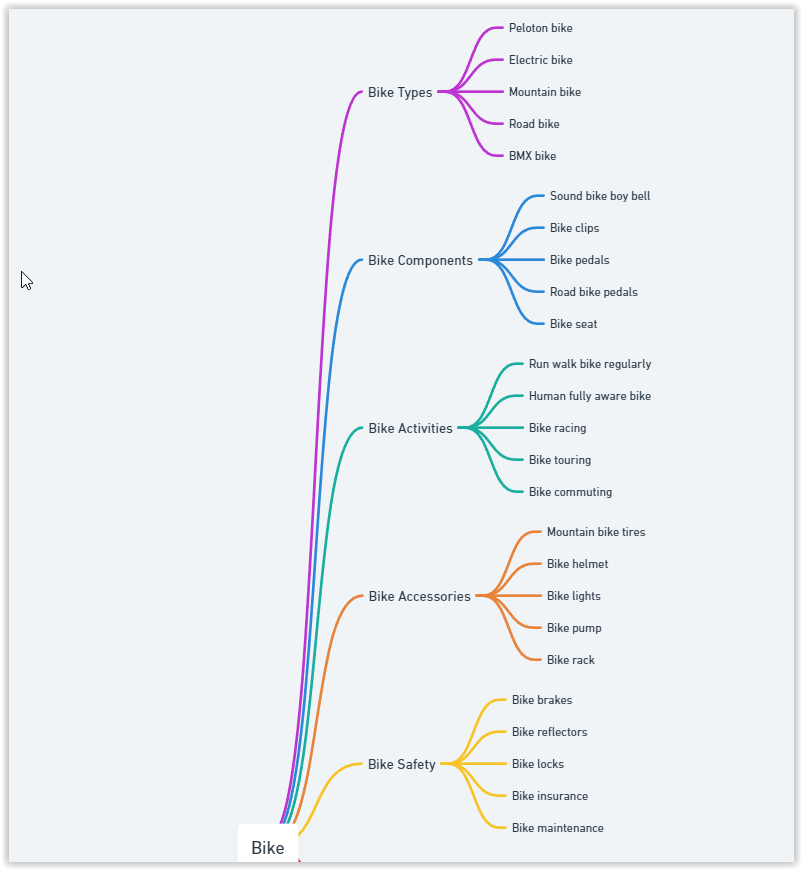 Screenshot from ChatGPT 4, January 2024
Screenshot from ChatGPT 4, January 2024
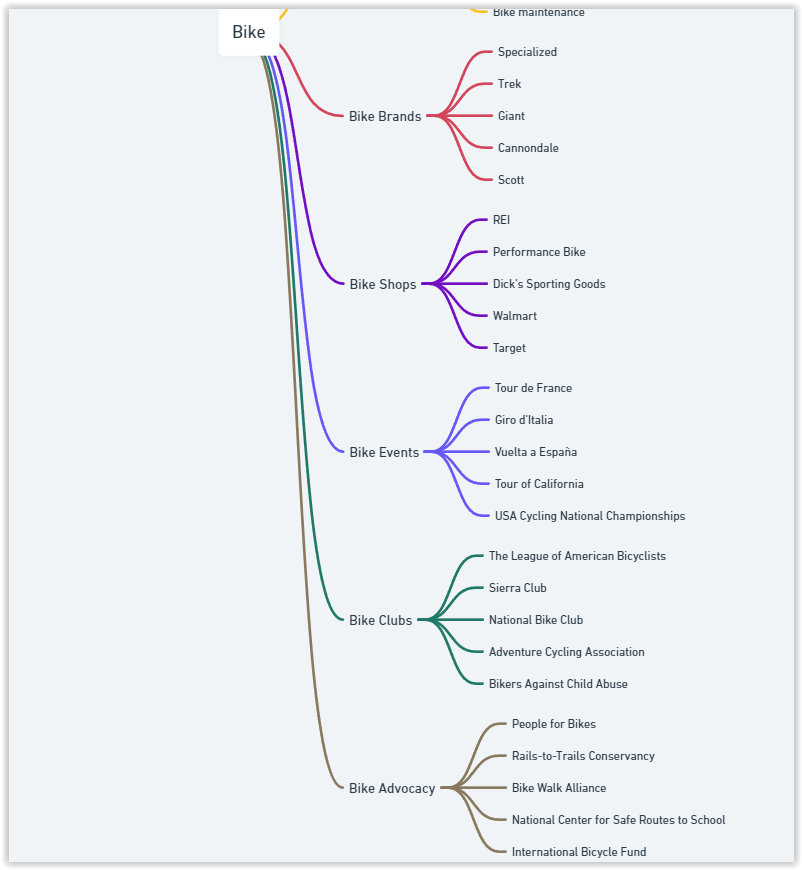 Screenshot from ChatGPT 4, January 2024
Screenshot from ChatGPT 4, January 2024
Now I’d like to suggest some advanced actions to anticipate Google SGE.
Advanced Strategies For Google SGE
Use Google’s PaLM 2 to check that the map covers all aspects of your topic. Integrate the map into your content research and writing process. Turn each sub-theme into a web page, blog post, or other form of content and link them together to create an interconnected web of content.This methodology provides a robust way to understand the role of generative AI in search engines and optimize for generative AI search features.
It’s enriched with detailed examples and explanations and focuses not just on topic optimization but on prioritizing content quality and targeting specific search intentions.
Human intervention remains critical to search intent and content quality.
The combination of a skilled writer and AI can enhance content optimization, using tools to maximize the efficiency and relevance of your ecosystem.
With the advent of generative AI, any SEO professional can build their own tool.
More resources:
Are LLMs And Search Engines The Same? The 6 Best AI Search Engines To Try Right Now How Search Engines WorkFeatured Image: Summit Art Creations/Shutterstock

 Kass
Kass 




























